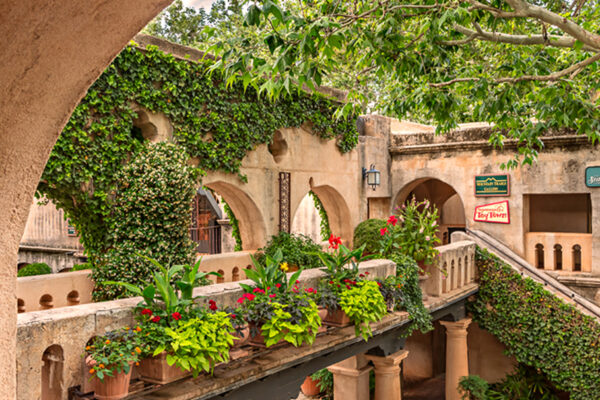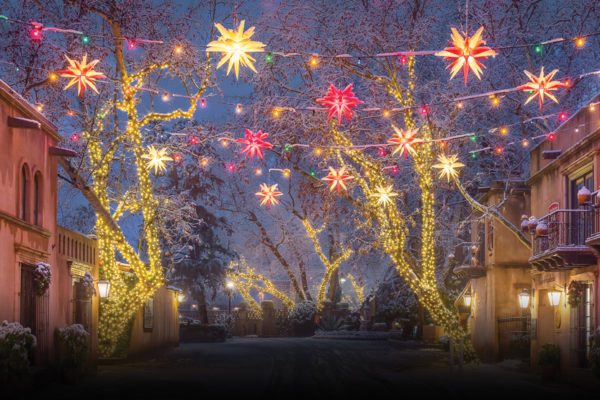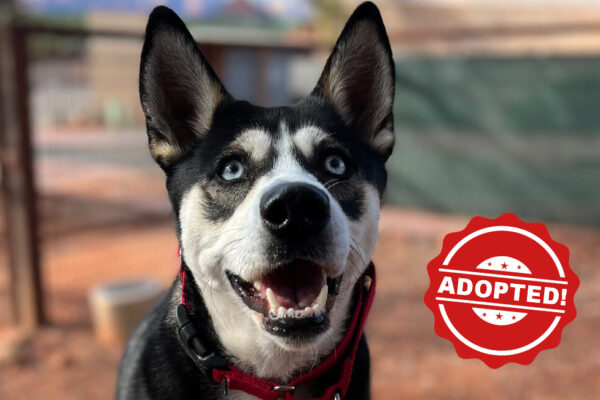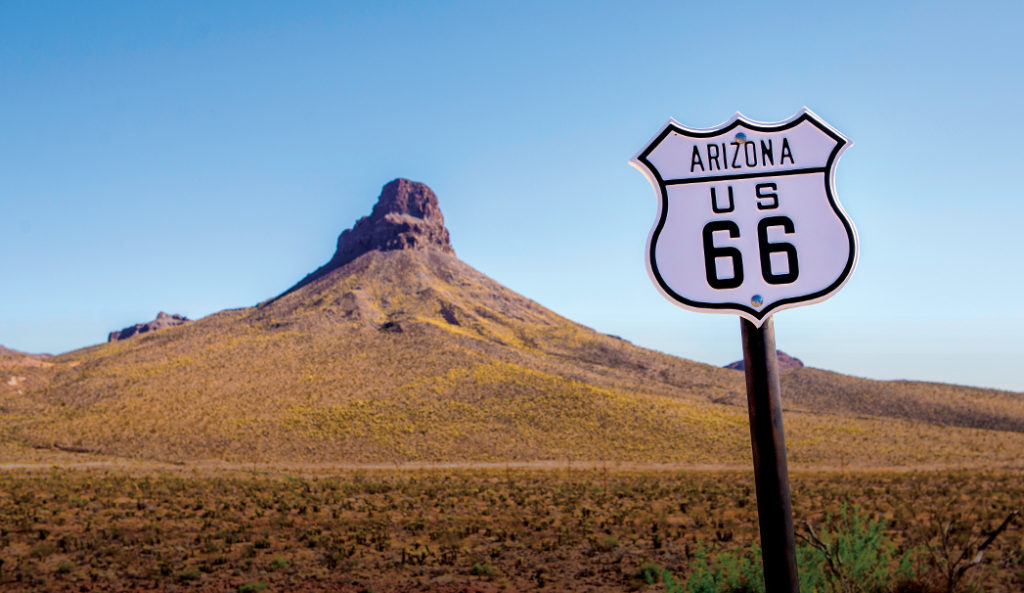
Abandoned Arizona Route 66 Desert Sign.
WILLIAMS
Located about one hour from the Grand Canyon, Williams’ tagline is (understandably) “The Gateway to the Grand Canyon.” But there’s also plenty to do and see in Williams. Visitors drive through
more than three miles of ponderosa pine forest and can see North American animals in their natural habitats at the approximately 160-acre Bearizona (bearizona.com). You might spot beavers, porcupines, otters, bobcats, javelina, red foxes, and of course, bears.
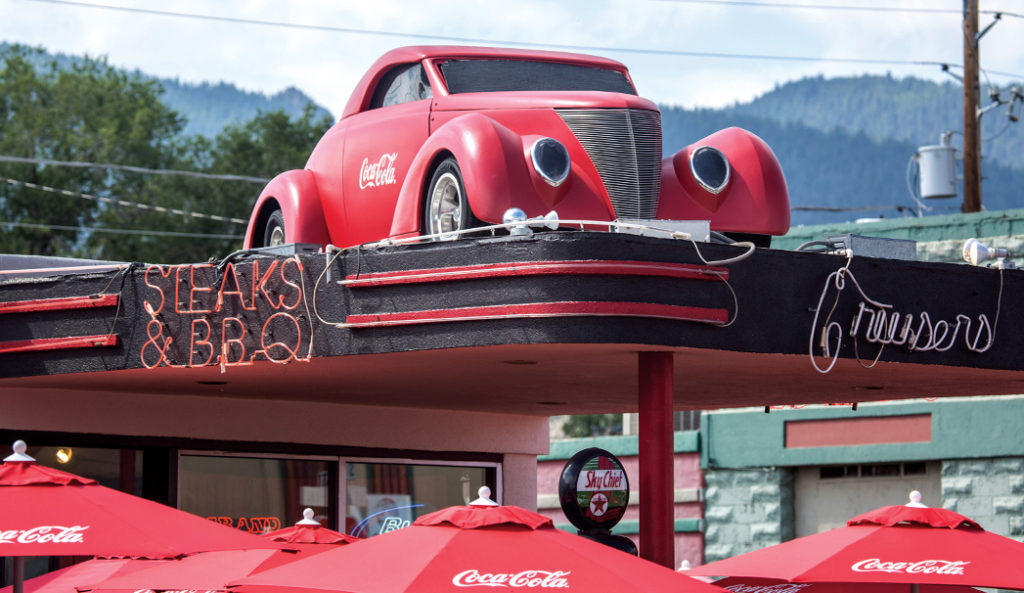
Cruisers BBQ Restaurant in Williams, Arizona. Photo courtesy of Experience Williams.
Belly up to the bar and step back in time at Goldie’s Route 66. The 1950s-style diner comes complete with a Betty Boop doll at the front, a Memory Lane plastic map pined up above the counter outlining Route 66 stops and plush leather chairs. Pull up a seat at the counter and dig into burgers and fries that are cut-pressed and cooked to order. The staff also can whip up malts and milkshakes to help soothe your sweet tooth.
Pete’s Route 66 Gas Station Museum is another throwback to the past. See vintage cars of all stripes in addition to memorabilia like fridges and signs – all housed in an old-timey gas station. For a more modern experience, consider The Grand Canyon Brewing and Distillery (grandcanyonbrewery.com). Enjoy the company’s proprietary beer and spirits paired alongside calzones, pizzas and hearty appetizers like Fresh Beer Rings, Cheese Curds and Brewery Wings.
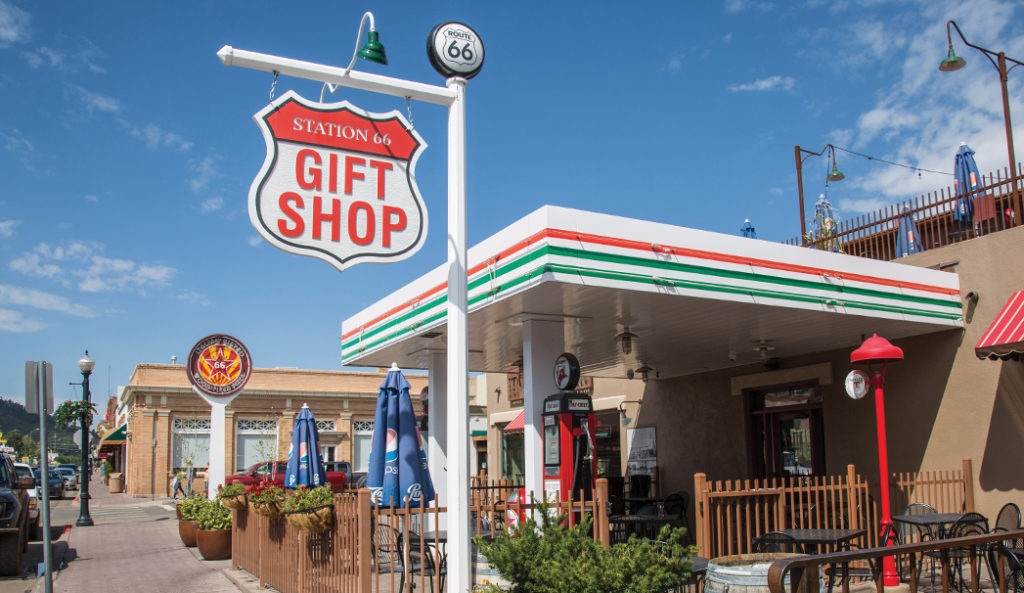
Station 66 Giftshop in Williams, Arizona. Photo courtesy of Experience Williams.
“Whether you crave a burger from a diner on Route 66, need to find the perfect made-in-Arizona souvenir, want to get up close and personal to the wildlife at Bearizona or board the train to the Grand Canyon – Williams has a little bit of everything,” says Heather Hermen, marketing representative, Experience Williams.
SELIGMAN
Located between Kingman and Flagstaff, Seligman kicks off the longest remaining stretch of Route 66 in the United States. The town is often called “The Birthplace of Historic Route 66.” One of the primary reasons being that Seligman residents – most notably barber Angel Delgadillo – rallied the state of Arizona to designate Route 66 as a historic highway. If this story sounds familiar, it’s because it served as the inspiration behind the movie “Cars.”
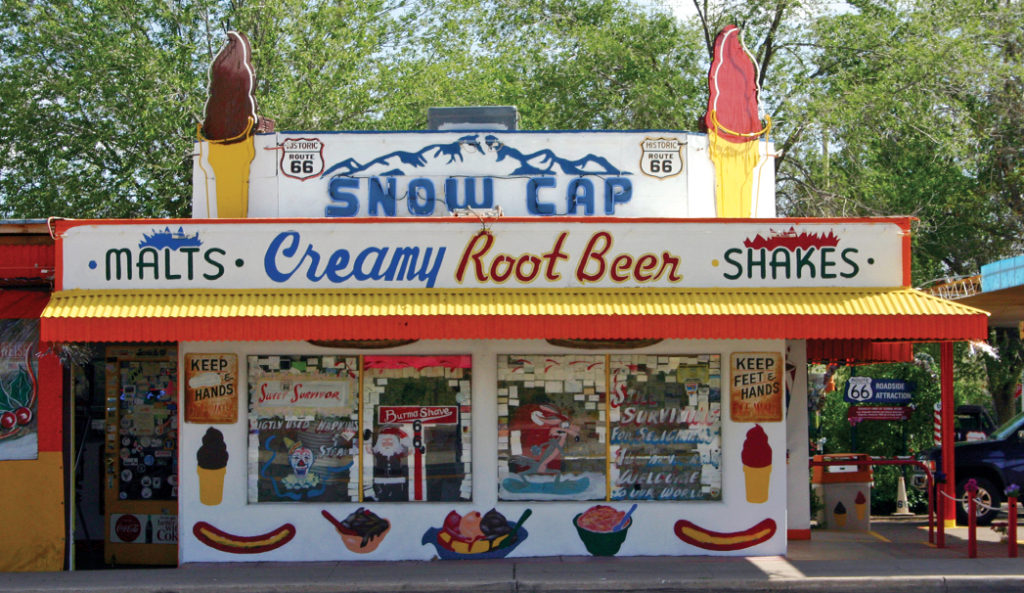
Delgadillo’s Snow Cap Drive-In in Seligman, Arizona. Photo by Julian Smith.
“Seligman is a one-street town. But you absolutely have to go because you have to go to Delgadillo’s Snow Cap Drive-In, which is an ice cream shop/restaurant but also the kitschiest, goofiest place on Route 66 run by the nicest people on the planet,” says Jessica. “It’s not just like you order an ice cream cone. It’s like you have this whole experience with the owner or with his staff where they are teasing you. They’ll squirt an old ketchup bottle at you, but a string comes out.”
Angel’s brother Juan ran the place back in the day, and it’s still family-owned. Originally built in 1953 out of scrap lumber, this spot pays tribute to Seligman and Route 66. Step inside to order burgers, malts and shakes from the counter. Be sure to check out the vintage Chevrolets and road signs behind the restaurant before you leave.
KINGMAN
Kingman is often called the “The Heart of Historic Route 66,” and the city pays homage to that history with the Arizona Route 66 Museum (mohavemuseum.org/az-route-66-museum.html). Located in the city’s historic Powerhouse Building, the museum gives tourists a glimpse into the history of The Mother Road. Watch a one-hour long video of the history of Route 66. Visitors also can see the Electric Car Museum of vintage cars of all types. See if you can spot country musician Willy Nelson’s cherry red golf cart.
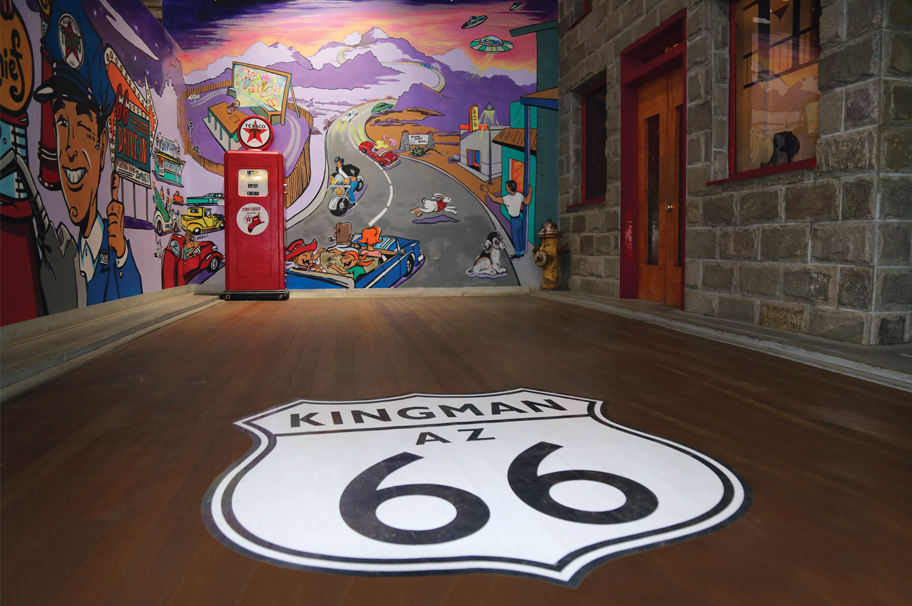
Route 66 Museum in Kingman, Arizona. Photo courtesy of Kingman Visitor Center.
The can’t-miss-it pink and turquoise exterior of Mr. D’z Route 66 Diner – renowned for its homemade root beer and pizza – make it worth stopping by. Get a kick out of the circular turquoise bar stools and Route 66 memorabilia on the walls. You’d be in good company. Oprah and her friend Gayle King have dined here.
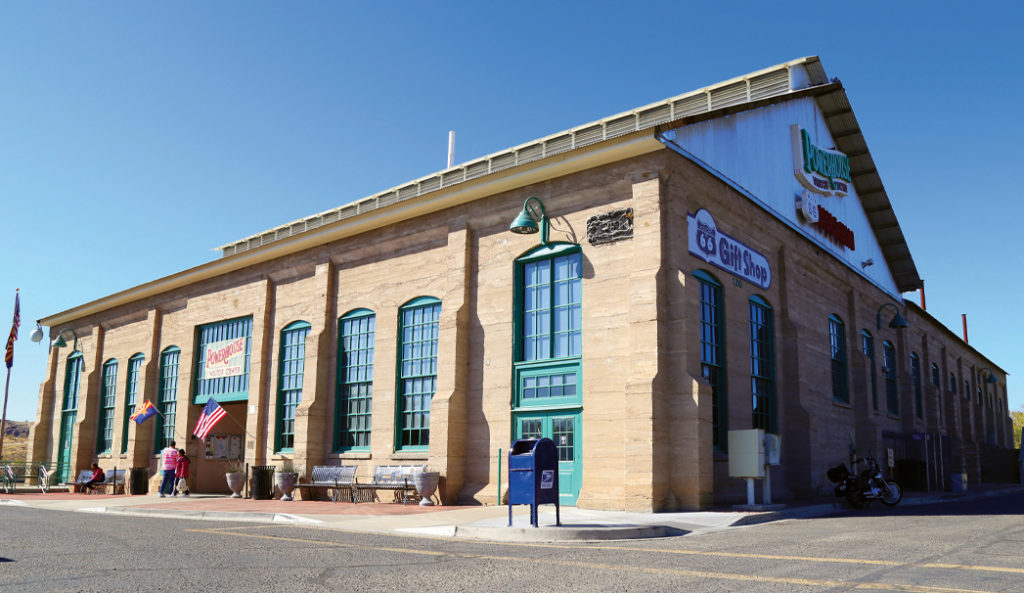
Route 66 Visitor’s Center in Kingman, Arizona. Photo courtesy of Kingman Visitor Center.
Open since 2010, Desert Diamond Distillery (desertdiamonddistillery.com) touts itself as the oldest craft distillery in Arizona. Desert Diamond Distillery or “D3” distills four rums and one vodka. Visitors can take 20- to 30-minute long behind the scenes tours of the distillery. They also can enjoy flights and cocktails made with this spot’s spirits. By the time this publishes, Desert Diamond plans to serve lunch in its on-site train car. The hope is that fine dining service will be offered in April or May.
For a unique Route 66 roadside attraction, consider stopping by Giganticus Headicus. This striking needs-to-be-seen-to-believed 14-foot green tiki-style head is a great place to snap a perfect photo. This sculpture is displayed at the Route 66 Antares Visitor Center. Located in the old Kozy Korner RV Park main building on Historic Route 66, the visitor center features a restaurant, gift shop, art gallery, a convenience store and gorgeous desert views.
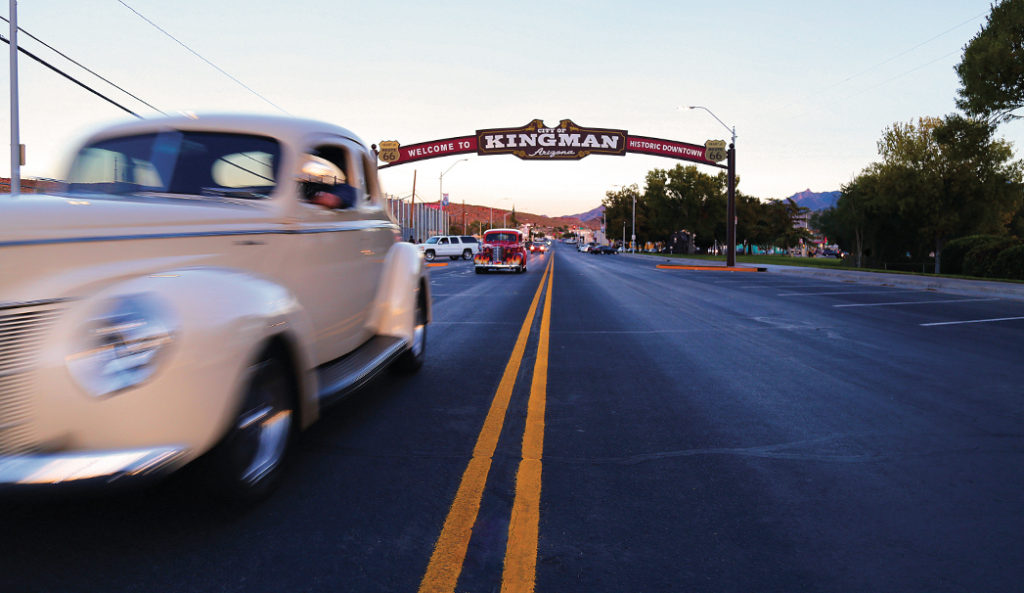
Kingman Arch in Kingman, Arizona. Photo courtesy of Kingman Visitor Center.
“Kingman’s rich history is owed to America’s move west. From Beale’s Wagon Road during the California gold rush to the railroad, Route 66, and Charles Lindberg dedicating Arizona’s first commercial airport in 1929. Our pioneering past is echoed in the architecture of Kingman’s historic downtown, which is dotted with museums, restaurants, shops, breweries and colorful murals echoing the stories of our small town. Visitors especially enjoy the downtown atmosphere during our car shows, block parties or just on the balcony at the local wine bar a nice evening throughout much of the year,” says Josh Noble, Tourism Services Manager, City of Kingman Office of Tourism.
WINSLOW
Perhaps most famous for being mentioned in the lyrics of The Eagles’ track, “Take it Easy,” the first place you’ll want to visit in Winslow is the, well, the literal corner in the Standin’ on the Corner Park. Located in downtown Winslow on the corner of Kinsley and Second streets, snapping a photo with a bronze statue of the song’s co-writer Glenn Frey is a must here.
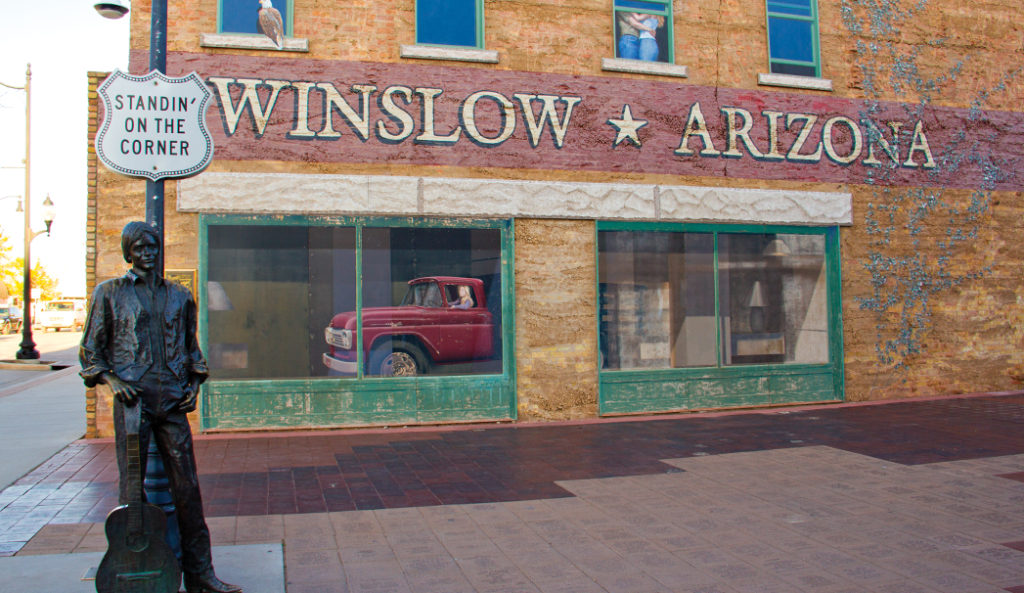
Standin’ on the Corner Park in Winslow, Arizona. Photo by Donavan Seschillie.
Another must-visit spot? The city’s most prominent hotel, La Posada, (laposada.org) which is steeped in history. Largely considered to be designed by one of the very few female architects of her time, Mary Jane Colter – who was employed by the legendary hospitality business, the Fred Harvey Company. “La Posada is like a museum, a hotel and an architectural marvel,” says Jessica.
Even if you don’t book a room here, it’s worth just wandering around the interior of the property and seeing the meticulously landscaped gardens outside. The lobby features distinctly Southwest features like woven rugs, painted ceilings, plush red leather couches and a turquoise-painted fireplace. Upstairs, you’ll find the striking contemporary paintings by the wife of the owner of the hotel, Tina Mion, displayed on the walls.
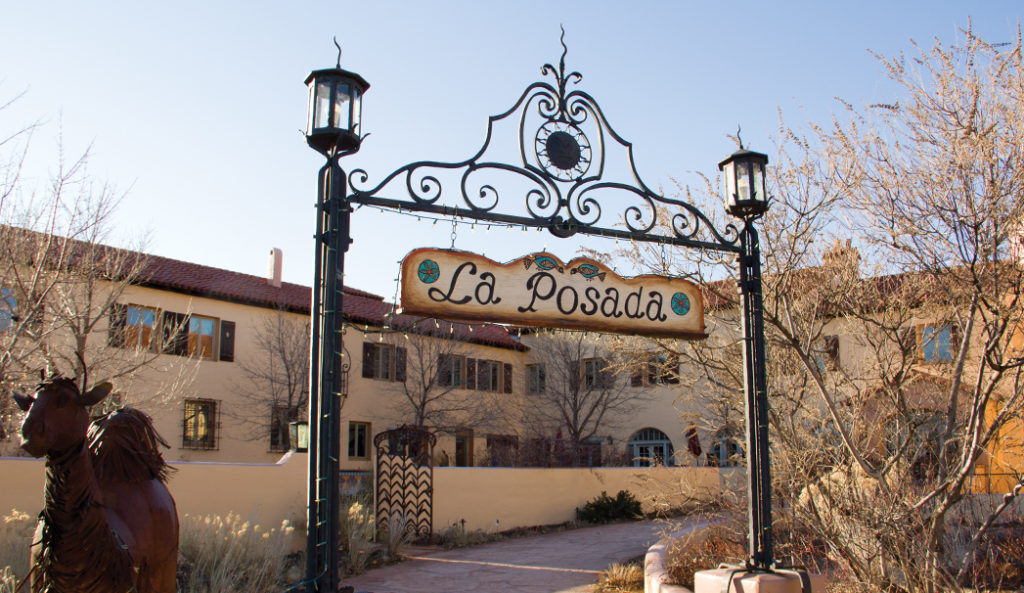
La Posada in Winslow, Arizona. Photo by Donavan Seschillie.
According to the property’s website, the hotel opened in 1930. During its heyday, La Posada hosted the likes of Albert Einstein, John Wayne, Amelia Earhart and Franklin D. Roosevelt. The hotel closed in 1957 and was reopened as the Santa Fe Railway offices in the 1960s. The building was nearly demolished several times during the next four decades, until it was purchased and renovated by owner Allan Affeldt and his wife Tina in 1997.
If you have the time, consider making reservations at the La Posada’s Turquoise Room (theturquoiseroom.net). Chef John R. Sharpe whips up everything from retro Fred Harvey dishes to Southwestern cuisine made from scratch. Diners can enjoy plates like the Wild Platter, crispy goose, served over an onion, sage, and rustic bread stuffing with orange Oaxaca sauce, Colorado farmraised elk medallion with a black currant sauce, a green chile tamale topped with bison, elk and wild boar chili, all finished with a fresh vegetable medley. Jessica tell us that if you can’t snag a reservation in the main dining room, you can also order the same food menu from the Martini Lounge.
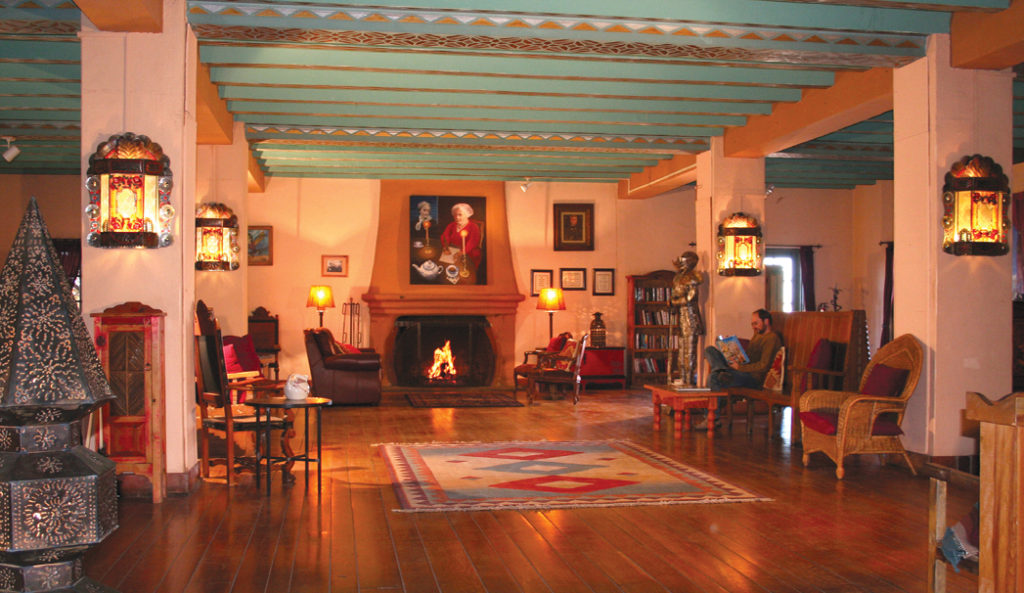
La Posada in Winslow, Arizona. Photo courtesy of La Posada.
If you’re searching for a recreational activity, consider wandering around and seeing more than 300 ancestral Puebloan archaeological sites at the 4,000-acre Homolovi State Park (https://azstateparks.com/homolovi). Homolovi is Hopi for “Place of the Little Hills.” This state park also serves as a center for research about the late migration period of the Hopi Native Americans from the 1200s to the late 1300s.
HOLBROOK
Holbrook is home to the Wigwam Motel (sleepinawigwam.com). But the name is somewhat of a misnomer, as the hotel rooms are shaped like teepees. Consider booking one of the 15 “wigwams” and sleep inside 28-foot concrete teepees that were originally built in 1950. The Wigwam was part of a chain that flourished in the 1940s and 1950s, but now there’s just three left standing, according to Jessica. The hotel is pet friendly and recommends booking at least two weeks in advance. Vintage cars are parked throughout the property. It’s worth stopping here just to check out the cars. The motel also features a museum, which features a small collection of Holbrook’s most famous natural resource: petrified wood.
You shouldn’t make a trip to Holbrook without hitting up the Rainbow Rock Shop. The first thing you’ll see? The massive model dinosaurs like the green stegosaurus, created by the shop’s owner out of chicken wire. “They’re so cute. But they’re also really weird,” says Jessica.
A sign will tell you not to jump or sit on them. After you’ve snapped your pictures, browse the shelves and shelves stacked high with petrified wood. If you’ve never seen it, petrified wood is solid quartz that can appear in a rainbow of colors like reds and oranges. Seeing it in person is mesmerizing. You won’t want to stop marveling at the petrified wood and how a piece of wood can be transformed into a solid piece of quartz after millions of years.
PETRIFIED FOREST NATIONAL PARK
Located just outside of Holbrook, Petrified National Forest Park (nps.gov/pefo) is one of the most beautiful places we’ve ever been to. Look forward to stunning, expansive desert skies that allow you to see for miles and huge petrified wood pieces scattered throughout with gorgeous, multicolored centers that all appear different. You’ll see hundreds of pieces of petrified wood, and we can all but guarantee that they’ll continue to captivate you. But beyond that, get ready to explore a largely untouched nearly 300 square miles gorgeous, natural site.
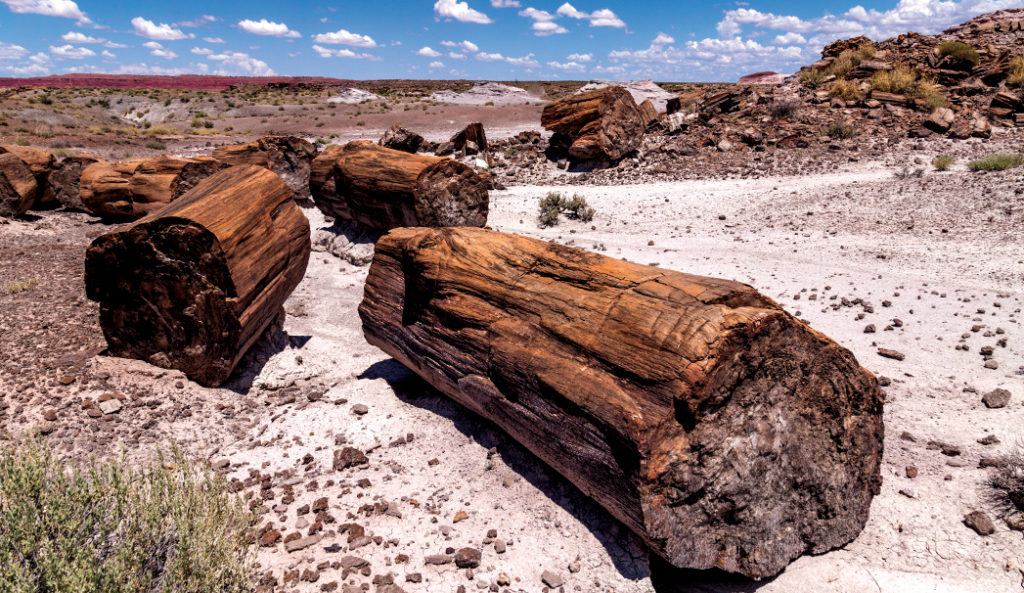
Petrified Forest National Park. Photo courtesy of NPS.
“It’s spectacularly beautiful. It provides opportunities for being in a national park that’s not overly congested. There’s lot of different topics that might capture the imagination of various people,” says Sarah Herve, acting chief of interpretation at Petrified Forest National Park. “We have a lot of opportunities for people who like to take photographs or who enjoy being in beautiful places.”
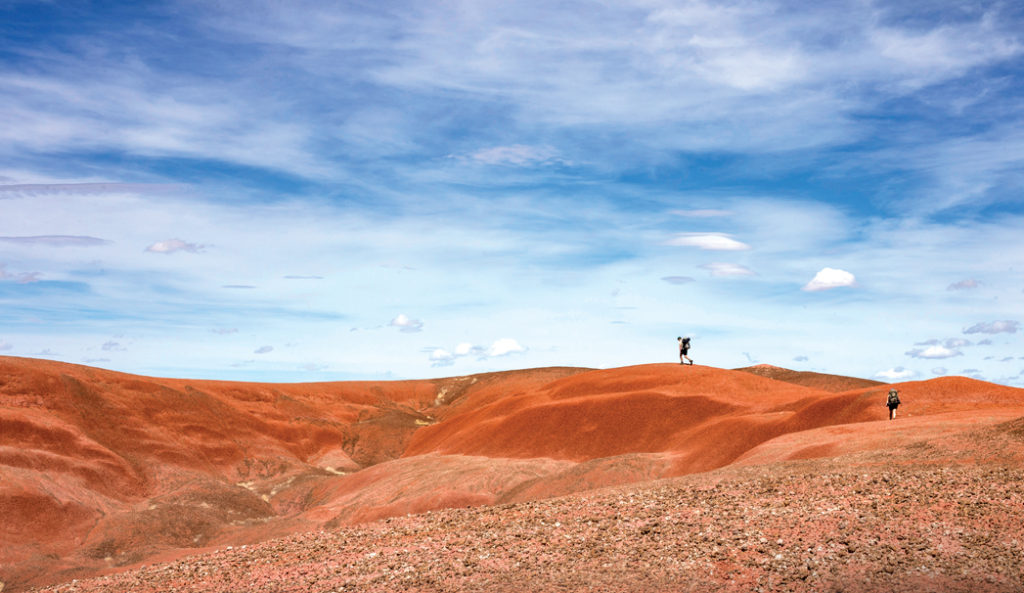
Petrified Forest National Park. Photo courtesy of NPS.
You can drive through most of the park and stop at sites that interest you. There’s a pullout where you can see a section of historic Route 66. This is the only national park that contains a part of historical Route 66. See a Studebaker. Walk along Route 66. You’ll also see a line of telephone polls that marks the road bed. A portion of the Painted Desert also lies in Petrified Forest National Park. Similar to Sedona’s red rocks that change in the light, expect striped variations of lavenders, rich grays, red, oranges and pinks that change depending on where the sun is located in the sky.
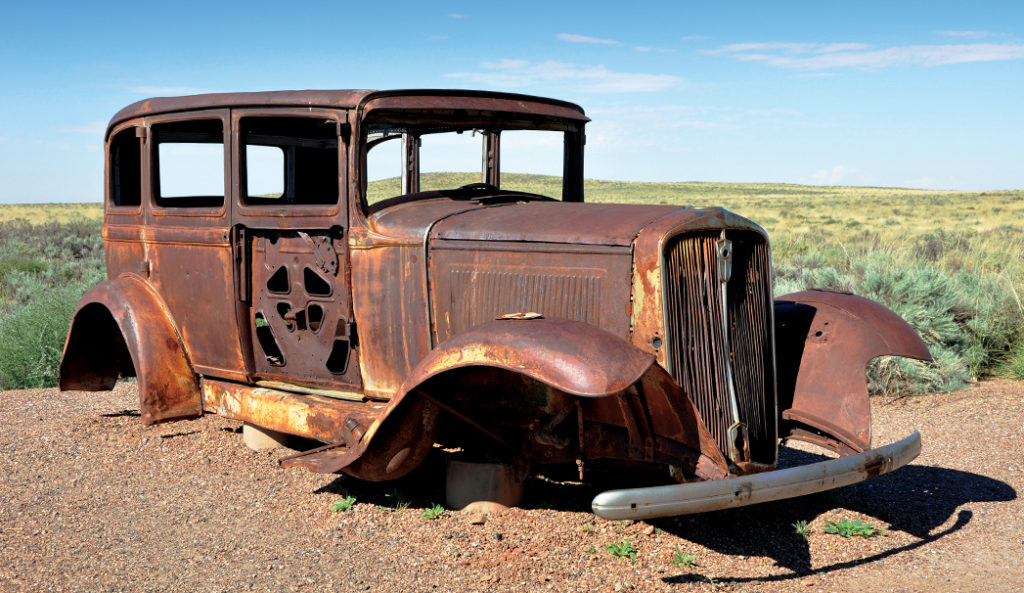
Petrified Forest National Park. Photo courtesy of NPS.
Park guests can hike, backpack, explore the backcountry, see petroglyphic scenes and learn more about the geographic uniqueness of the region. Dogs are welcome, and the park even has a Bark ranger program that you can sign up for at the visitor center or entrance booths. Pet owners will be given treats. You’ll even see shorter water fountains for animals besides the taller ones for humans. If you’ve visited before and are looking for another way to experience the park, a campground is slated to open in 2021.
TWO GUNS
Just over 30 minutes from Flagstaff, ghost town Two Guns has a fascinating backstory.
“Two Guns was one of those places that sprung up along Route 66 as a tourist trap,” says Jessica. “It was a zoo, slash fake Indian burial grounds, fake Wild West theme park. All of it totally fake. That’s what interesting.”
It’s also allegedly haunted and was the site of a massacre of Apaches by the Navajo. The cave where this occurred was called the Apache Death Cave. Although you can see the Apache Death Cave, Jessica tells us it’s dangerous to venture inside. In 1925, Henry “Two Gun” Miller created a zoo (one of the ruined buildings says Mountain Lions on the front), a restaurant, a shop and living spaces. Following a dispute, Miller killed the property owner. Miller was later mauled by the zoo animals. Two Guns was revived sometime in the 1970s and then burned down. You can see the abandoned structures like a Texaco Gas Station and stone building ruins that still stand there today. Many of the remaining places are blanketed in bright, colorful graffiti.
“It’s just creepy, in a way that only Arizona ghost towns can be creepy,” says Jessica. “It’s such a weird place. But when I was there, I ran into so many other tourists. It’s creepy, but you’re not isolated either. You just pull off to the side of the road and start walking.”
GRAND CANYON CAVERNS
Located in Peach Springs, Grand Canyon Caverns (gccaverns.com) are the largest dry caverns in the United States. “Dry” meaning there’s no more formations growing in them. Only 3 percent of caverns in the world are dry according to David Farley’s “Underground Worlds: A Guide to Spectacular Subterranean Places.” Visitors can choose from five different tours to see them with their own eyes. The caverns are accessible via elevator and located 200 to 300 feet underground. Enjoy meals 200 feet underneath the Earth at the on-site restaurant Caverns Grotto. Visitors can even sleep in total silence inside the caverns at the Cavern Suite. The room is 200 feet by 400 feet and features a 70 foot ceiling. You also can watch rodeo at the on-site Rodeo Ring.
OATMAN
Essentially the last city in Arizona on Route 66 before you reach the California border, Oatman is perhaps most well-known for its high population of wild burros that roam the streets. The former gold mining town has found a second life as a tourist destination. The Western town comes complete with wooden streets, kitschy shops, saloons and staged shootouts. Allegedly actors Clark Gable and Carole Lombard spent their honeymoon at The Oatman Hotel, which now functions as a restaurant and museum. Plus, just getting to Oatman is an adventure in and of itself.
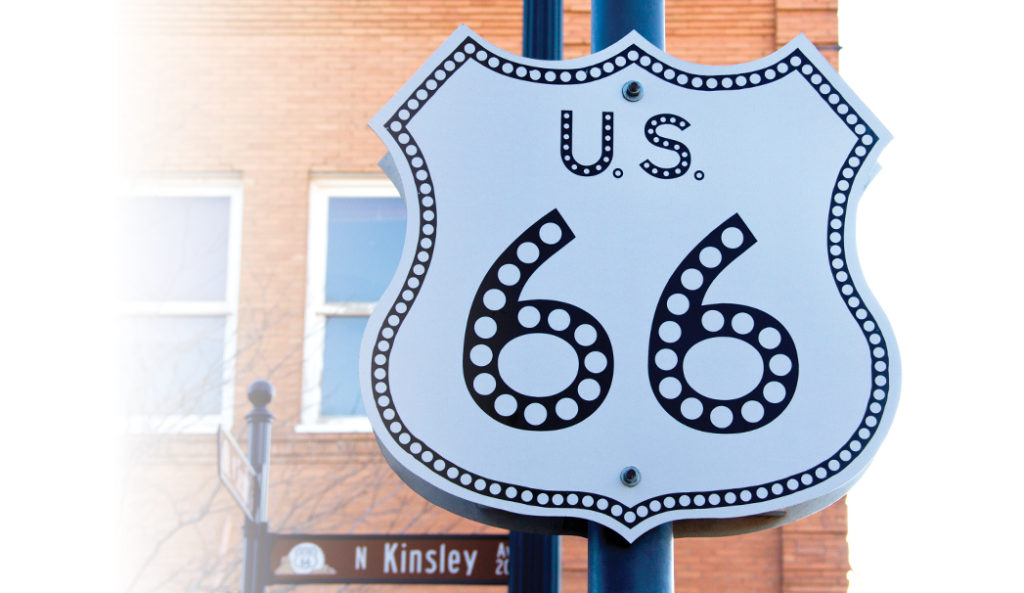
Route 66 sign on the corner in Winslow, Arizona. Photo by Donavan Seschillie.


